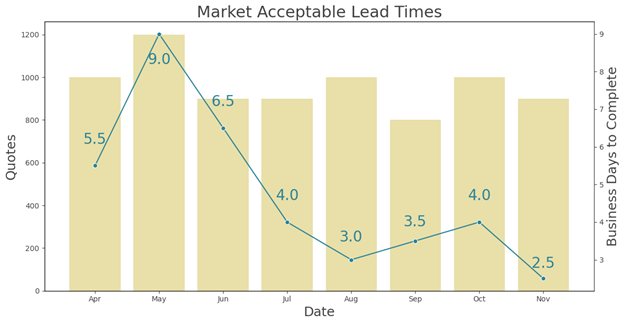In the fast-paced world of marketing, leveraging analytics has become not just a competitive advantage but a necessity. Industries of all sorts are turning to data-driven insights to enhance their strategies and manufacturers are no different. Analytics has been shown to streamline operations, improve efficiency, and help run impactful strategies.
Welcome to our multi-part series created for manufacturers navigating the marketing world. In this post, we’ll tackle manufacturing marketing, discussing various tools and strategies that contribute to real-world success. Let’s explore how manufacturers can harness data analytics to optimize their marketing initiatives.
Analytics in Manufacturing
Analytics has solidified its place in the manufacturing industry, revolutionizing how businesses optimize operations, enhance productivity, and deliver superior products and services.
It is a transformative force that allows manufacturers to extract actionable insights from vast amounts of data generated across their processes, supply chains, and client interactions. It can play an important role in everything from identifying inefficiencies to improving quality to enabling personalized experiences and customized offerings.
Manufacturing Analytics Tools
Tools play a pivotal role in transforming raw data into insights that drive strategic decision-making. The right tools can be crucial for extracting value from data efficiently and effectively.
Tools are indispensable in the analytics landscape and here’s why:
When working for a B2B manufacturing company, we knew that lead times were quite long compared to competitors and while this was obvious anecdotally, data was needed to back it up. Once we figured out how to pull timestamp data in the ERP, we could work on reducing lead times by identifying and addressing bottlenecks in each phase of the process.
As we pinpointed problems and implemented fixes, we showcased progress by displaying KPIs, demonstrating a reduction in lead times over time.

In another scenario, predictive analysis became a key tool for strategic planning. We used it to estimate demand by product and accounted for seasonality, which significantly impacted planning and inventory management. This enables proactive decision-making by anticipating customer behavior and trends.
Customer segmentation has also been a focus and is extremely useful when allocating budget and time efficiently, and effectively. Dealing with thousands of customers, we categorized them by leveraging cluster analysis, which not only played into resource allocation but also helped us identify inefficiencies in pricing across different client segments.

Below are some examples of analytics tools used to create solutions to tackle the issues clients face:
- Database or CRM Systems
- Oracle ERP
- Salesforce
- Microsoft Dynamics
- Data Extraction & Management
- SQL
- Statistical & Predictive Analysis
- STATA
- Data Visualization
Leveraging Data to Develop a Strategy
Developing a solid marketing strategy in the manufacturing industry relies on leveraging data to understand customer behavior and market trends.
For example, beginning with demand forecasting, manufacturers can use predictive analytics to anticipate fluctuations by product and season, allowing for proactive inventory management and production planning.
From there, manufacturers can analyze data to identify high-value customer segments. Analyzing customer data allows manufacturers to segment based on factors like purchasing behavior, location, industry, and more while taking into account revenue and margin metrics.
This then enables teams to create personalized marketing campaigns and sales strategies that target these customers. Messages and offers can be created based on customer preferences and behavior which not only enhances customer satisfaction but also improves conversion rates and creates stronger connections.
Finally, visualizing the data through tools makes it easier to monitor progress and continue making impactful data-driven decisions to tweak campaigns and strategies. Analytics can help determine what’s working and what’s not, identifying platforms and channels that are most worth your time and ensuring resources are allocated efficiently.
Tips & Tricks for Analytics in Manufacturing
Analytics are invaluable for a variety of reasons- risk management, innovation, competitive edge, you name it. It empowers organizations to make informed decisions and optimize. However, the true cornerstone of effective analytics lies not just in the numbers themselves but the processes and people behind its interpretation and application. Harnessing the full potential of innovation is possible if you keep a few important points in mind:
- Foster Collaboration. Integrate data insights between departments. Break down silos between production, sales, marketing, and other departments to gain a holistic view of operations and customer insights. This maximizes the impact across an organization, encouraging teamwork, leveraging diverse perspectives and expertise, and gaining deeper insights from data that can be utilized in decision-making processes across the company.
- Stay Agile. Agile methodologies emphasize iterative development, frequent feedback loops, and the ability to pivot strategies based on discoveries and challenges. In the dynamic landscape of a business, agility is key to adapting quickly to changing conditions and emerging opportunities.
- Invest in Data Quality. The foundation of effective analytics lies in the quality and reliability of the data being analyzed. Investing in good data practices and robust management systems ensures that manufacturers can trust the integrity of their data for making critical business decisions.
- Know Your Vision. Clearly define your business-specific goals early on and identify the KPIs that will align with them. These objectives provide direction for analytics initiatives and serve as measurable benchmarks to guide your decision-making and gauge progress.
The Takeaway
By adopting advanced analytics tools and harnessing the power of big data, manufacturers can position themselves for long-term success in a competitive market. Leveraging these data-driven decision-making practices helps manufacturers stay ahead of the competition and achieve sustainable growth in today’s dynamic business landscape.
Looking for a partner in your journey to center data in your strategic plans? emfluence can help with that.
Ready to jump right into collaborating? Contact our team today to set up a chat with your new strategic marketing partner.



